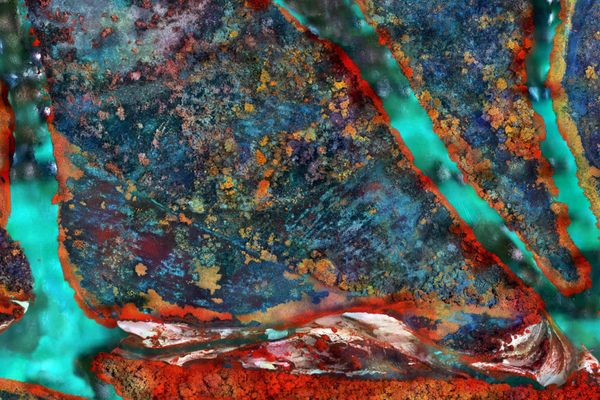The Wild Frogs, Newts and Salamanders That Have Eluded Cameras for Decades
Startling images of hard-to-document creatures.
Scientists discovered this toad during an expedition to Colombia. The species, which has yet to be officially described and named, was dubbed the “Monty Burns” toad by lead scientist and photographer Robin Moore, who compared its profile to that of the nefarious villain from the popular TV series The Simpsons. (All Photos: Robin Moore/bioGraphic)
A version of this story originally appeared on bioGraphic.com.
Maybe it’s their compellingly bulging eyes.
Maybe it’s because they often look like they’ve been let loose in a paint store filled to the brim with lidless buckets of brightly hued paint. Whatever the reason, amphibians are among the planet’s most charismatic ambassadors for imperiled biodiversity. Faced with a variety of threats, from disease to habitat loss, about half of the world’s roughly 7,000 species of amphibian are threatened with extinction—and more than 250 of those species haven’t been seen since the turn of this century.
That’s why Conservation International scientist Dr. Robin Moore launched a six-month, 21-country effort to search for frogs, toads and salamanders that hadn’t been documented in decades. From Borneo to Brazil, Colombia to Congo, and Israel to India, more than a hundred scientists joined this ambitious effort to find some of the most elusive animals on Earth. Here are some of their most spectacular discoveries—animals that have reappeared (or in some cases appeared for the first time) against the odds, proving their resilience and offering hope for future amphibian conservation efforts.
Glass Frog

Glass frogs are so-named because their translucent skin provides a surprisingly revealing window into their internal organs. These frogs are often good indicators of environmental health, being particularly sensitive to toxins and changes in climate. This species (Hyalinobatrachium ruedai) is one of several that are commonly found in the Chocó forests of Colombia. Their abundance is a testament to the relatively large and undisturbed swaths of forest that remain in this region.
Glass Frog Spawn

During a search for the Limon harlequin frog, the team found the eggs of a glass frog (Cochranella resplendens) on a leaf overhanging a stream in southern Ecuador. Suspended in mid-air, the eggs are less vulnerable to predators than those laid in water, but they are still targeted by parasitic flies and predatory snakes. Some glass frog eggs hatch early in response to vibrations produced by approaching snakes, dropping into the stream below to complete their development. The tadpoles are elongated with powerful tails to cope with fast-flowing water. Eventually, as adults, they will crawl out of the stream to live in the tree canopy.
Reticulated Glass Frog

Scientists encountered this reticulated glass frog (Hyalinobatrachium valerioi) in the Osa Peninsula of Costa Rica, one of the most biologically rich forests in the world. The frog was photographed peering through the leaf on which it was found, backlit to illustrate the translucence of the frog. Armed conflict has kept developers out of these forests, resulting in vast swathes of intact rainforest and a high diversity of frogs.
Ventriloquial Frog

Until recently, only three individuals of the ventriloquial frog (Eleutherodactylus dolomedes) had ever been recorded. A 2010 expedition to Haiti rediscovered the species after 19 years without a sighting. The frog was named by herpetologist Blair Hedges for its seeming ability to throw its voice, making it extremely challenging to locate—especially since it is the species’ call that first alerted the search team to its presence.
Variable Harlequin Frog

The variable harlequin frog was one of the first “lost” frogs to make a remarkable reappearance. The species (Atelopus varius) vanished suddenly from streams across Costa Rica and Panama in the late 1980s and early 1990s, one of the many victims of the deadly chytrid fungus that has decimated amphibian populations around the world. It was thought to have gone extinct until it was rediscovered in a remote stream in Costa Rica in 2003. Two current populations have been identified to date, and scientists are carefully monitoring and studying both.
Solomon Islands Eyelash Frog

The Solomon Islands eyelash frog (Ceratobatrachus guentheri) is a striking species that mimics—in both color and shape—the leaf litter of its home on the forest floor. This frog is an interesting example of a frog that undergoes direct development, meaning that there is no free-living tadpole stage. Eggs are laid in small hollows at the base of trees from which the young emerge as fully formed, albeit tiny, froglets.
Borneo Rainbow Toad

The Borneo rainbow toad (Ansonia latidisca) was one of the top ten “most wanted” lost amphibians in the world during the Search for Lost Frogs project in 2010. After eight months of repeated searches, an intrepid team of scientists led by Dr. Indraneil Das struck gold, rediscovering the toad after 87 years without trace. The team was the first to record the incredible coloration of the animal, and named it the rainbow toad. In May 2016, the scientists retraced their steps with Robin Moore to find and photograph the toad in the wild.
Long-limbed Salamander

The scientific name of the long-limbed salamander, Nyctanolis pernix, translates as “night anole,” because this nocturnal salamander runs and leaps more like an anolis lizard than a salamander. The species was discovered in the remote Cuchumatanes Mountains of northwest Guatemala in 1975—and then disappeared for more than 30 years, before being rediscovered by local biologist Carlos Vasquez in 2009.
Ruby-eyed Toad

An entirely new species that has yet to be officially described and named, the ruby-eyed toad was discovered during an expedition to the Chocó forests of Colombia. Upon learning that the habitat of the newly discovered toad was threatened by logging, the search team worked quickly with local partner Fundacion ProAves to create a new protected are called Las Tangaras Reserve, purchasing land and building a research center to help ensure the species’ survival.
Limon Harlequin Frog

Harlequin frogs are some of the most beautiful and threatened of all frogs. More than 100 species exist, and almost all of them have been decimated by disease, climate change, habitat destruction or some combination of these threats. In southern Ecuador, a new species dubbed the Limon harlequin frog (Atelopus sp.) was found in a small section of stream—but when an international team traveled there to document the frog, they found debris spewing into the stream from the construction of a new road. Their most poignant find was this dead female harlequin frog splayed in the shallow waters with a male trying to mate with her. The male died in captivity shortly afterward.
















Follow us on Twitter to get the latest on the world's hidden wonders.
Like us on Facebook to get the latest on the world's hidden wonders.
Follow us on Twitter Like us on Facebook